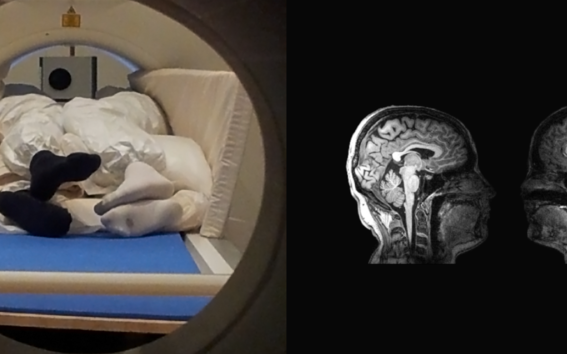An MRI in each other's arms shows how physical contact alters the brains of couples

Researchers at Aalto University and Turku PET Centre have developed a new method for simultaneous imaging brain activity from two people, allowing them to study social interaction.
In a recent study, the researchers scanned brain activity from 10 couples. Each couple spent 45 minutes inside the MRI scanner in physical contact with each other. The objective of the study was to examine how social contact activates the brain. The results were published in the theme issue Social Interaction in Neuropsychiatry of the journal Frontiers in Psychiatry.
“This is an excellent start for the study of natural interaction. People don’t just react to external stimuli, but adjust their actions moment-by-moment based on what they expect to happen next,” says Riitta Hari, emerita Professor at Aalto University.
Ordinary magnetic resonance imaging is used to scan one person at a time. In the device developed at Aalto University, the head coil used for regular brain scans was divided into two separate coils. This new design allows for simultaneous scanning of two brains, when the individuals are positioned close enough to each other inside the scanner. During scanning, the participants were face-to-face, almost hugging each other.
When instructed by the researchers, the subjects took turns in tapping each other's lips. Looking at the brain scans, the researchers could see that the motor and sensory areas of the couples’ brains were activated.
Studying the fundamentals of human interaction
“During social interaction, people's brains are literally synchronised. The associated mental imitation of other people's movements is probably one of the basic mechanisms of social interaction. The new technology now developed will provide totally new opportunities for studying the brain mechanisms of social interaction,” says Professor Lauri Nummenmaa from Turku PET Centre.
“For example, during a conversation or problem solving, people’s brain functions become flexibly linked with each other. However, we cannot understand the brain basis of real-time social interaction if we cannot simultaneously scan the brain functions of both persons involved in social interaction,” Riitta Hari says.
The study was funded by the European Research Council (ERC) and the Academy of Finland.
Read more:
You can read the full research paper for free online: https://dx.doi.org/10.3389/fpsyt.2020.00279
Contact:
Read more news

Aalto University to host INNOVA Europe 2026 Grand Final in Espoo
Aalto University will host the INNOVA Europe 2026 Grand Final in Espoo, bringing together leading student-led startups from European universities.
Finnish AI Region Secures Second Term with Top Marks from EU
Finnish AI Region (FAIR) EDIH has been selected to continue operations for a second term with excellent ratings. European Union continuation funding enables service expansion from the beginning of 2026. Aalto University is one of 10 partners in FAIR.
Unite! Seed Fund 2026: Open for applications
The 2026 Unite! Seed Fund call is officially open, offering funding across three strategic lines: Student Activities, Teaching and Learning, and Research and PhD. Deadline for applications is 20 March 2026.






